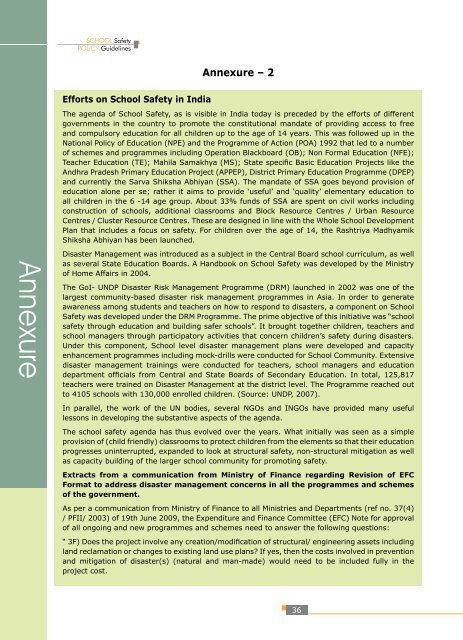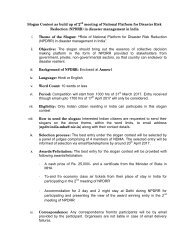National Disaster Management Guidelines School Safety Policy
School-Safety-Policy
School-Safety-Policy
You also want an ePaper? Increase the reach of your titles
YUMPU automatically turns print PDFs into web optimized ePapers that Google loves.
SCHOOL <strong>Safety</strong><br />
POLICY <strong>Guidelines</strong><br />
Annexure – 2<br />
Efforts on <strong>School</strong> <strong>Safety</strong> in India<br />
The agenda of <strong>School</strong> <strong>Safety</strong>, as is visible in India today is preceded by the efforts of different<br />
governments in the country to promote the constitutional mandate of providing access to free<br />
and compulsory education for all children up to the age of 14 years. This was followed up in the<br />
<strong>National</strong> <strong>Policy</strong> of Education (NPE) and the Programme of Action (POA) 1992 that led to a number<br />
of schemes and programmes including Operation Blackboard (OB); Non Formal Education (NFE);<br />
Teacher Education (TE); Mahila Samakhya (MS); State specific Basic Education Projects like the<br />
Andhra Pradesh Primary Education Project (APPEP), District Primary Education Programme (DPEP)<br />
and currently the Sarva Shiksha Abhiyan (SSA). The mandate of SSA goes beyond provision of<br />
education alone per se; rather it aims to provide ‘useful’ and ‘quality’ elementary education to<br />
all children in the 6 -14 age group. About 33% funds of SSA are spent on civil works including<br />
construction of schools, additional classrooms and Block Resource Centres / Urban Resource<br />
Centres / Cluster Resource Centres. These are designed in line with the Whole <strong>School</strong> Development<br />
Plan that includes a focus on safety. For children over the age of 14, the Rashtriya Madhyamik<br />
Shiksha Abhiyan has been launched.<br />
Annexure<br />
<strong>Disaster</strong> <strong>Management</strong> was introduced as a subject in the Central Board school curriculum, as well<br />
as several State Education Boards. A Handbook on <strong>School</strong> <strong>Safety</strong> was developed by the Ministry<br />
of Home Affairs in 2004.<br />
The GoI- UNDP <strong>Disaster</strong> Risk <strong>Management</strong> Programme (DRM) launched in 2002 was one of the<br />
largest community-based disaster risk management programmes in Asia. In order to generate<br />
awareness among students and teachers on how to respond to disasters, a component on <strong>School</strong><br />
<strong>Safety</strong> was developed under the DRM Programme. The prime objective of this initiative was “school<br />
safety through education and building safer schools”. It brought together children, teachers and<br />
school managers through participatory activities that concern children’s safety during disasters.<br />
Under this component, <strong>School</strong> level disaster management plans were developed and capacity<br />
enhancement programmes including mock-drills were conducted for <strong>School</strong> Community. Extensive<br />
disaster management trainings were conducted for teachers, school managers and education<br />
department officials from Central and State Boards of Secondary Education. In total, 125,817<br />
teachers were trained on <strong>Disaster</strong> <strong>Management</strong> at the district level. The Programme reached out<br />
to 4105 schools with 130,000 enrolled children. (Source: UNDP, 2007).<br />
In parallel, the work of the UN bodies, several NGOs and INGOs have provided many useful<br />
lessons in developing the substantive aspects of the agenda.<br />
The school safety agenda has thus evolved over the years. What initially was seen as a simple<br />
provision of (child friendly) classrooms to protect children from the elements so that their education<br />
progresses uninterrupted, expanded to look at structural safety, non-structural mitigation as well<br />
as capacity building of the larger school community for promoting safety.<br />
Extracts from a communication from Ministry of Finance regarding Revision of EFC<br />
Format to address disaster management concerns in all the programmes and schemes<br />
of the government.<br />
As per a communication from Ministry of Finance to all Ministries and Departments (ref no. 37(4)<br />
/ PFII/ 2003) of 19th June 2009, the Expenditure and Finance Committee (EFC) Note for approval<br />
of all ongoing and new programmes and schemes need to answer the following questions:<br />
“ 3F) Does the project involve any creation/modification of structural/ engineering assets including<br />
land reclamation or changes to existing land use plans? If yes, then the costs involved in prevention<br />
and mitigation of disaster(s) (natural and man-made) would need to be included fully in the<br />
project cost.<br />
36



